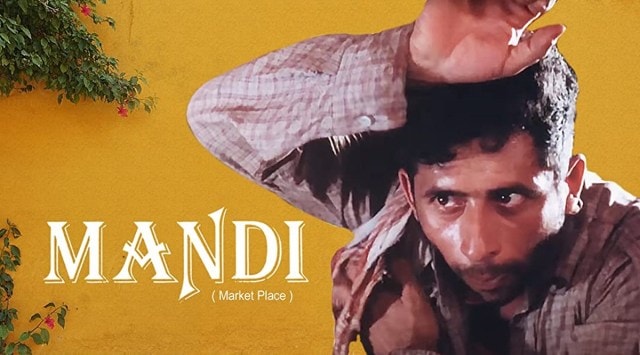Click here to follow Screen Digital on YouTube and stay updated with the latest from the world of cinema.
A career seen through supporting roles: Naseeruddin Shah in Mandi, Monsoon Wedding and others
Here is a look at four films where Naseeruddin Shah in a supporting role pretty much ended up stealing the show.
 Naseeruddin Shah in Mandi. (Photo: Amazon Prime Video)
Naseeruddin Shah in Mandi. (Photo: Amazon Prime Video)At 72, Naseeruddin Shah still remains one of the finest actors of our times. In a body of work that spans close to five decades and two hundred films, here is an actor who has pushed the boundaries of acting with every possible role. He broke on the scene with his outstanding performance in Shyam Benegal’s Nishant, following which he acted in a slew of films by the same director. Not long after, Shah became the poster boy of the parallel cinema movement in India.
With a frame that was lean, with eyes that could cook up rage as fast as they could cook up pathos, Shah pretty much captured the very essence of the common man in India, at a time when our screens were dominated by the testosterone driven heaviness of the Bachchan version of the Angry Young Man. A graduate of the National School of Drama, Shah was one of the first actors of our country who tried to merge the demands of performance across two different formats – live performance in theatre and recorded performance in cinema. Having rigorously studied drama, he put into praxis the varied models of method acting and showed a command over his body that had hardly been seen before on screen.
Naseeruddin Shah was perhaps among those first slate of actors in our cinema for whom stardom came as a contingent result of their decades long work on screen. Working consistently with the same lot of directors and on films with shoe-string budgets, a new model of masculinity was also ushered into the realm of Hindi cinema. This cinema was different from the films of Bollywood which still remained heavily occupied with the excesses of the silver screen and the demands of a star fuelled system. Shah was not interested in a masculinity that derived virility from committing violence against the bad guys, or from the wooing of a slew of suitors.
Instead, his men were flawed beings. They were men whose masculinity was not as performative as it was internal. It was an extension of their internal selfhood that often surfaced to show the depth of the scars they had incurred over the course of their battles against society. These were men who were educated in the highest orders, walking halls of the country’s biggest bureaucracies and yet their disillusionment with the government was palpable. These were men who were messy in their passions – not papering over the cracks with exquisite poetry but rather owning up to their own devilish desires and impish failures.
It was perhaps this reason why Naseeruddin Shah left a mark even in movies where he was cast in a supporting role. At the cost of screen time, he chose characters which were fleshed out to perfection – with shades that could fit an entire spectrum. And hence, in most cases even when he was up against formidable talent from generations before and after him, Shah left a lasting impact. In many cases, it was his character that pretty much became the talking point of the film itself. To be an actor who leaves such a lasting mark means possessing a screen presence so commanding that it forces you to not divert your vision even for a single second from the screen. And it is only after the films ends that you realise, Shah was cast in nothing more than a supporting role.
Here is a look at four of my favourite films, across his six decade long career, where Shah in a supporting role pretty much ended up stealing the show.
1. Mandi
This Shyam Benegal classic satirised the banality of the flesh trade much before Srijit Mukherjee came at it with his sledge-hammer style of filmmaking in Begum Jaan. The film boasted an ensemble cast featuring the who’s who of parallel cinema. Starting from Shabana Azmi to Smita Patil and Soni Razdan to Ratna Pathak Shah, this movie did not have single dull moment. But despite Azmi’s performance as a brothel madame who is just perpetually frustrated with the workings of the brothel and its adjoining politics or Patil’s sexual naiveté, it was eventually Naseeruddin Shah’s performance as Tungrus, the pimp that stole the show. Throughout the film, Tungrus is seen occupying the fringes. He rarely utters a word. He follows and obeys commands thrown his way. His face captures hurt and disappointment at every step of the way. As viewers know, this is a man who has a story to tell that will be perhaps as compelling as the ones boasted of by the women he is sworn to protect in the brothel. Shah, despite the awkwardness of the physical stature of the character, imbues him with a quiet dignity that makes us root for the man and his many palpable moments of desire and longing. Eventually when everyone deserts Azmi, it is Tungrus alone who stays and as madame and pimp set out to seek the promise of a golden future that hardly seems visible on the horizon, we realise that this was a film was much about Azmi as it was about the strength and wreckage of Shah’s character.
2. Monsoon Wedding
 (Photo: IFC Productions, Mirabai Films, Delhi Dot Com)
(Photo: IFC Productions, Mirabai Films, Delhi Dot Com)
This Mira Nair classic, featuring yet another ensemble cast boasting of the literal who’s who of indie cinema, has Naseeruddin Shah cast opposite a stupendous Lilette Dubey. Shah played the role of a patriarch of an upper class South Delhi household, caught in the throes of preparing for the wedding of his daughter. I have always maintained that Delhi is by far one of the most complex cities in our country to decode. Within the region of the NCR, there are multiple personality and character traits that the city upholds that allows the space for ample drama. Monsoon Wedding till date is one of the finest films ever to crack the monster that is the privileged bubble of South Delhi. These are people we all know. These are families we have all seen. These are secrets we have only heard of at parties. Yet, these are parties we all yearn to be invited to. Shah was fantastic as the fading patriarch of this mad-cap Indian family, which gets together for the sole purpose of a marriage. He nailed the rich Delhi-based Punjabi archetype flawlessly. In the avatar of a man trapped in the prison of a marriage of his own making, Shah’s character is forced to confront the mountain of denial that has piled over the years in the family. No longer being able to ignore the darker edges of his image driven existence, Shah has two standout moments. One where he breaks down out of exhaustion in the arms of his wife and the other climactic moment where he rages against an entire family. In the end, despite the drum beats of the wedding itself, you feel the rage and hurt of a man, who at the end of the day wanted little more than to keep his falling family together for good.
3. Zindagi Na Milegi Dobara
It is high time someone said it, and hence I will oblige by asking everyone to just for one moment consider the meta nature of the Farhan Akhtar and Naseeruddin Shah scene in Zindagi Na Milegi Dobara. The build-up to this scene started from the very beginning of the film. We, along with Farhan’s Imraan, want to meet the man who abandoned his mother all those years ago. We want to satiate our own curiosity and know why Imraan chooses to demand answers from a man who never wanted him in the first place. It was supposed to be the showdown scene of the film. Instead we get cold desolation. It is to the credit of Zoya Akhtar that, in such few words, she wrote a scene that seemed like an entire film in itself. Perhaps this was the culmination of her own strained relationship with her father over the years – something about which she has extensively spoken in interviews. But the credit for the eventual impact of the scene also goes to Shah and Akhtar’s performance. Although Akhtar had an arc that pretty much blossomed over the course of two hours, Shah had one, and one scene alone. In five minutes he sent us from feeling sorry to abject rage to resentment to quiet resignation at the fate of a man who just doesn’t know how to say sorry for a crime he thinks he never committed. The showdown did not involve people breaking ceramic jars or cutting open canvases. There were a few curt words spoken. A few stares delivered. And a lifetime of hurt translated into celluloid magic.
4. Gehraiyaan
 (Photo: Amazon Prime Video)
(Photo: Amazon Prime Video)
Much has been said about Gehraiyaan, which polarised viewers to such a deep extent that it is almost impossible to have a straight conversation about it with anyone. But despite all the hatred the film received (which I personally felt went overboard), one could not deny that Bollywood was finally agreeing to not shy away from darker topics in its mainstream narratives. Despite being marketed as a story of infidelity, Gehraiyaan essentially was the story of generational trauma passed on in dysfunctional families. With a climax that was triggered by the revelation of a plot point that involved incest – this was the most Bollywood had packed into a film in a long time. Of course, the problem was poor writing and mediocre editing. But what prevented the film from becoming a complete wreck were the performances. Yet again, Naseeruddin Shah rose to the occasion by playing the role of a man who has been deeply bruised by his family and who insists on living a lie for the sake of his daughter. It was the first time in many years that I finally saw an actor this comfortable with his own age. Shah made no show of the fact that he is ageing. The tiredness of his character was never in our face. We saw the hunched shoulders. We noticed the length of the pauses between his words. And ultimately, we saw him in the absolute best scene of the film, where in a moment of truce he reaches out to his daughter in a final bid to save his family. Haters and lovers of the film alike extensively spoke about the impact of this scene – which was long felt after the credits had rolled in.


- 01
- 02
- 03
- 04
- 05
































